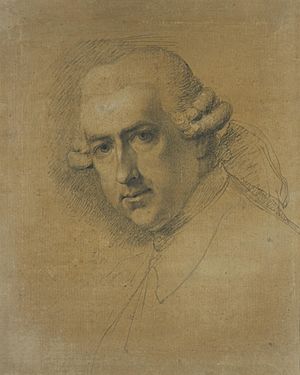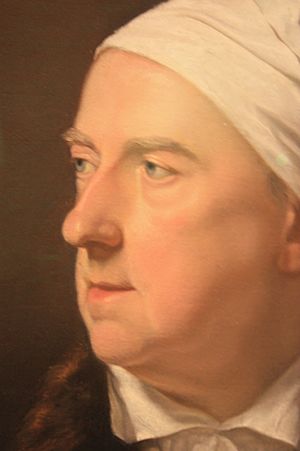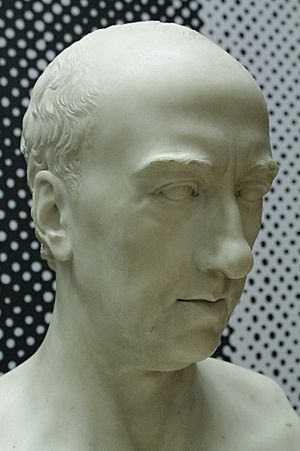Gavin Hamilton (artist) facts for kids
Quick facts for kids
Gavin Hamilton
|
|
|---|---|

Gavin Hamilton by Ozias Humphry, 1778, pencil, NGS
|
|
| Born |
Gavin Hamilton
1723 ODNB Lanarkshire, Scotland
|
| Died | 4 January 1798 (aged 74–75) |
| Nationality | Scots |

Gavin Hamilton (born in 1723 in Lanarkshire, Scotland; died in 1798 in Rome) was a talented Scottish artist. He was known for his large paintings of historical and classical scenes. But he was also famous for finding ancient Roman treasures near Rome. His work as both a painter and an archaeologist made him a very important figure in the art world of his time. He helped shape what people thought was good art in the Neoclassical style.
Contents
Life as an Artist
Gavin Hamilton was born in Scotland in 1723. By 1744, he had moved to Italy to study art. He likely learned in the studio of Agostino Masucci in Rome. From 1748 to 1750, he shared an apartment with other artists. Together, they explored cities like Naples and Venice.
After his studies, Hamilton returned to Britain. He spent several years (1751–1756) painting portraits in London. Then, he went back to Rome, where he lived for the next 40 years until he died.
Famous Paintings
Most of Hamilton's paintings were very large. They showed scenes from Greek and Roman history. He also painted a few portraits of his friends and family.
His most famous works are a series of six paintings based on Homer's Iliad. These paintings were meant to be as grand and powerful as Homer's epic poem. They were copied and shared widely, becoming very influential.
Another important painting was his Death of Lucretia (from the 1760s), also known as the Oath of Brutus. This painting inspired many other artists to create similar "oath paintings." One famous example is Jacques-Louis David's Oath of the Horatii (1784). Hamilton's painting showed the scene over Lucretia's dead body.
Recognition for His Art
In Rome, important people like writer Goethe and sculptor Antonio Canova admired Hamilton's classical paintings. However, his art was not as well-known or appreciated back in Britain. He did receive a special job to paint the altar piece for Sant'Andrea degli Scozzesi. This is the Scottish national church in Rome. For this, he painted the Martyrdom of St Andrew.
Discovering Ancient Treasures
Besides painting, Gavin Hamilton was also a successful art dealer and archaeologist. He led digs to find ancient Roman objects.
Excavations and Finds
From 1769 to 1771, Hamilton began digging at Hadrian's Villa in Tivoli. At first, he was looking for marble for his sculptors to fix old statues. His workers even dug in a swampy area, "up to the knees in muddy water." They found sculptures that had been thrown there centuries ago.
After 1771, Hamilton excavated other sites near Rome. These included Tor Colombaro, Albano, Monte Cagnolo, Ostia, the Villa Fonseca, Roma Vecchia (the Villa dei Quintili), Castel di Guido, and Gabii.
Honest Dealing
During Hamilton's time, it was common for people to heavily restore ancient Roman sculptures. Sometimes, they even completely refinished the surfaces. But Hamilton had a reputation for being honest. He did not unfairly change the sculptures he found.
Hamilton sold many of the artworks he discovered to British collectors. Two of his most important clients were Charles Townley and William Petty, 2nd Earl of Shelburne. Hamilton once wrote to Charles Townley that "the most valuable acquisition a man of refined taste can make, is a piece of fine Greek Sculpture."
In 1771, Hamilton found the famous Warwick Vase at Hadrian's Villa. He sold it to Sir William Hamilton, who was a British diplomat and art expert.
Working with Other Artists
Gavin Hamilton worked closely with the famous artist Giovanni Battista Piranesi. He also gave early advice to Antonio Canova, a young sculptor. Hamilton told Canova to move away from his earlier, more decorative style. Instead, he encouraged Canova to focus on studying nature, the best ancient sculptures, and a few top modern sculptors.
In 1785, Hamilton bought Leonardo da Vinci's Virgin of the Rocks. He sent it to London to be sold. This is the version of the painting now kept at the National Gallery in London.
Rules for Discoveries
Finding and selling ancient items could be a bit tricky. The Pope claimed one-third of all excavated works. He also had the right to stop important treasures from leaving the country. Hamilton was good at making generous gifts to the Vatican's Museo Pio-Clementino. He also paid landowners for the right to dig on their property. This helped him keep good relationships with everyone.
Gavin Hamilton died in Rome on January 4, 1798.
See also


